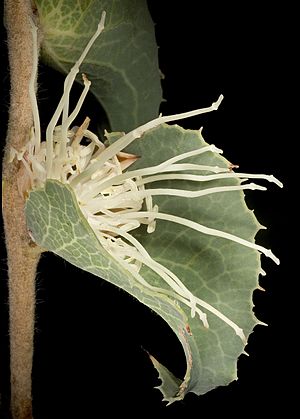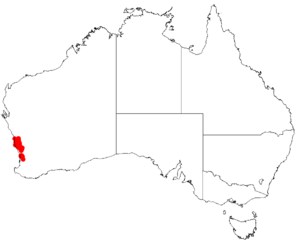Shell-leaved hakea facts for kids
Quick facts for kids Shell-leaved hakea |
|
|---|---|
 |
|
| Hakea conchifolia (photo: K.R.Thiele) | |
| Scientific classification | |
| Genus: |
Hakea
|
| Species: |
conchifolia
|
 |
|
| Occurrence data from Australasian Virtual Herbarium | |
The Shell-leaved Hakea (its scientific name is Hakea conchifolia) is a cool shrub. It belongs to the Proteaceae plant family. You can find it growing naturally in the western part of the Wheatbelt region in Western Australia. This small plant is special because its stiff, shell-like leaves wrap around its flowers.
Contents
What Does Shell-leaved Hakea Look Like?
The Shell-leaved Hakea is a small shrub. It usually grows to be about 0.3 to 1 meter (1 to 3 feet) tall. It has small branches that stand upright.
Leaves and Flowers
The branches can look different. Some might have soft, reddish-brown hairs. Others could have rougher hairs or thick, short, matted hairs. These hairs often fade away when the plant flowers.
The leaves are very unique, looking like shells. They are stiff and grow one after another on the branches. When they open up, they are about 3 to 7.5 centimeters (1 to 3 inches) long. They are also 30 to 70 millimeters (1 to 3 inches) wide.
These grey-green leaves have no hairs. They are widest near the stem. Each leaf looks a bit like a feather, with parts divided on both sides of a central stalk. Most leaves are shaped like a wide egg or a heart. They have sharp, wavy edges and are folded over, surrounding the flowers.
The flowers grow where the leaf meets the stem. Each cluster has about 15 to 18 flowers. The tiny stalk holding each flower is smooth and about 2.7 to 3 millimeters long. The flowers are usually creamy white, but sometimes they can be a pale pink. They bloom in winter, from June to August.
Fruit
After flowering, the plant produces egg-shaped fruits. These fruits are about 20 to 25 millimeters (0.8 to 1 inch) long. They are also 10 to 12 millimeters (0.4 to 0.5 inches) wide. Each fruit narrows down to a short, pointed tip, like a beak.
How Shell-leaved Hakea Got Its Name
The Shell-leaved Hakea was first officially described by a botanist named William Jackson Hooker. This happened in 1842. He wrote about it in his work called Icones Plantarum.
The scientific name conchifolia comes from two Latin words. "Concha" means "snail" or "shell." "Folium" means "leaf." So, "conchifolia" means "shell-leaf," which perfectly describes its unique leaves!
Where Shell-leaved Hakea Grows
The Shell-leaved Hakea grows in the northern sandy plains. You can find it from Irwin in the north down to the hills of the Darling Ranges near Perth.
This plant likes to grow in sandy, loamy, and gravelly soils. It prefers areas where the water drains well. You can often see it in heathland or in low woodlands.
Is Shell-leaved Hakea Safe?
The Western Australian Government's Department of Parks and Wildlife says that Hakea conchifolia is "not threatened." This means it is not currently in danger of disappearing.

